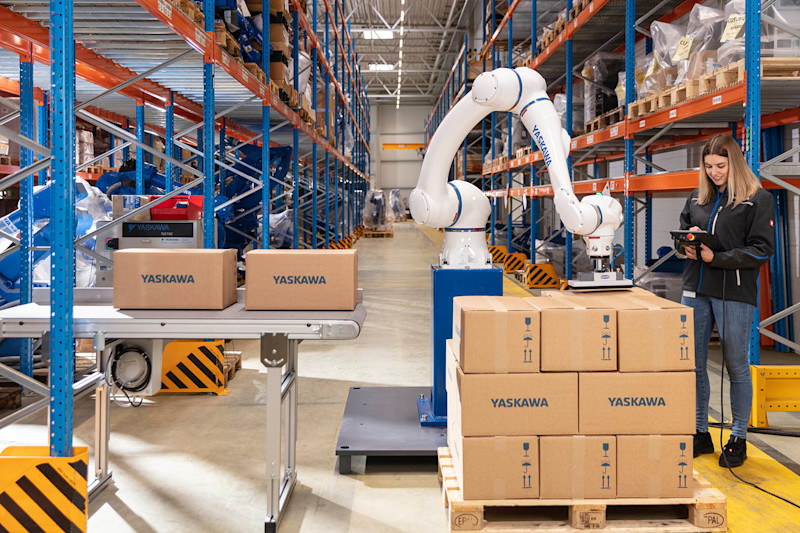Statistics from Statista show that in 2018, 11,550 collaborative robots – aka “cobots” – were sold in the U.S. market. The statistical source projects that in 2025 that number will reach 134,400 units. Given that that’s a whopping 1,064% increase, this raises the questions of just what a cobot is in the context of industrial robots as well as use – and not-use – cases for the equipment.
But some people may recall the early days of what are now considered “typical” industrial robots – the six-axis manipulators that come in sizes from small to gargantuan. In some cases companies were purchasing one fundamentally because they wanted to be considered current (and possibly cool). This was, in effect, somewhat like putting an industrial robot in the lobby for bragging rights and not on the factory floor, where it would be used to do actual work.
Then there were those instances when management figured that they were making a big investment in robots, so they were going to install that equipment in the most difficult applications they had on the factory floor. After all, wasn’t that what they were good for? Well, yes, but not for one’s first outing with the programmable manipulators.
So, whether it was having one as a “showcase” or putting the equipment in places that were extraordinarily complex, there was undoubtedly a delay in what could have been a quicker and more widespread deployment of this automation.
But while that tech has become common in factories – generally in medium to larger facilities but even in some smaller ones – cobots, while growing in number, are still somewhat new to many companies, filling a niche between the now-traditional six-axis devices and manual workers – or directly adjacent to other automation and humans. What’s more, this equipment can be of greater interest not only to those with larger facilities but small ones, as well.
As there is an increased need for reliable productivity, cobots can provide the way to achieve that even for organizations that don’t have deep familiarity with automation or programming skills. While those six-axis arms – so physically imposing that they served as little more than lobby ornaments – were once so challenging to set up and run that they required massive resources, cobots are designed and engineered for comparative simplicity in their appearance and in their setup.
If it is the right task, this simplicity can equate to productivity.
So, if you’re interested in the potential of deploying cobots in your operations, here are some key things you should know. This information was garnered from leading suppliers of cobots: ABB Robotics, Fanuc America, Kuka Robotics, Universal Robots, Yaskawa Motoman.
1. What Makes a Cobot a Cobot Versus a Robot?
The operative term is “safe” because it is meant to work collaboratively – or at least in the same space – with people. As Yaskawa America’s Bill Edwards, senior manager, collaborative robots, puts it:
“A cobot is a robot that has some combination of safety features and sensors in place that allow it to operate in the same space as a human worker. Typically, these sensors are going to be presence detection (laser scanners, lidar, light curtains) and/or power force limiting (PFL) sensors built into the robot arm. The RIA/A3 had also introduced criteria where the arm must also have a safe design, such as smooth finish and no sharp edges.”
Which is not to suggest that traditional robots aren’t safe. But they do require more in the way of protective barriers that keep people away from the work zone while the robot is in operation.
2. What Are the Ideal Applications for Cobots?
Cobots are ideally suited for applications that require an operator to frequently interact with the robot – like in the case of high-mix, low-volume production runs. The reduced time it takes for an operator to enter the collaborative robot cell, whether behind a fence or not, makes changeovers far quicker and less disruptive. Also, for tasks that require a lot of path programming, a cobot solution can be a good fit due to the simplified programming methods that have been recently developed, says Tim Paton, ABB Robotics, general industry segment manager.
Another way to consider whether a cobot is applicable comes from Travis Langford, channel development manager at Universal Robots: “The easiest way to think about it is that a cobot is human, not superhuman. Most industrial robots have superhuman speeds and can handle massive payloads. Cobots are more in the realm of human speeds and payloads.”
Adam Willea, district manager-Florida, Fanuc America, cites a couple of specific applications: “Ideal applications are slow material handling projects or inspection projects. With slow throughput material handling, this could be machine load/unload, packaging, palletizing, assembly, and so on.
“For inspection, this would either entail the robot carrying a camera/sensor and working it around a part for quality checks or, alternatively, carrying a part to present various angles to a fixed sensor/camera for the same inspection.”
3. What Are the Applications Best Avoided?
Universal Robots’ Langford provides a great image of what not to attempt: wrapping a shoebox with paper. A person should do the wrapping. Then the cobot can pick it up and stack it on a pallet. (Shoelace-tying is another example he provides that cobots are not well suited for.)
Cobots are comparatively simple devices and they should not be deployed in complicated tasks. Fanuc’s Willea lists other tasks to be avoided:
“Anything that requires high speeds, high payloads, dangerous tooling, or dangerous parts. Cobots are legally required to run much slower than industrial robots to maintain the contact-stop safety ratings. The current ISO standard is 150N force maximum at 1,000 mm/sec maximum speed (pending only fingers and arms are at risk of contact). If chest area, abdomen, other, are exposed to the cobot, speeds must be limited to 300 mm/sec.”
4. Why Would Someone Get a Cobot Rather Than a Conventional Robot?
ABB Robotics’ Paton answers: “Cobots are straightforward to program, deploy, and use, lowering the barriers to automation for first-time users and small to medium enterprises. There are a wide range of reasons an organization would opt to install one or more cobots rather than traditional industrial robots. Some of the most prominent reasons include the lower initial investment and overall operating costs of cobots, the ability for cobots to be more easily integrated into existing production lines, the ability to install and operate cobots without having to hire a robot programming expert.”
5. What Is the First Application That Someone Ought To Try With a Cobot?
This is a variation on a theme we’ve seen more than once already:
“Something simple. Very simple. A simple application with quick deployment,” says Kuka’s Ryan.
You want a win, so going simple is a way to get one.
Yaskawa Motoman’s Edwards provides some general specificity:
“This is subjective to the industry they are in, but look around for someone that looks like a robot doing a task and try a robot there. Simple, repetitive motions with limited payloads and reasonable speeds. Packing, picking, placing, palletizing, and simple welding are all easy ones to try. With welding, you can do more complicated welds, but a basic T-joint or fillet weld can be learned and taught in a matter of minutes. These are opportunities to automate a basic task that is otherwise wasting your skilled welder’s time.”
6. What Familiarity Does Someone Need With Automation To Install and Operate a Cobot?
“Organizations can install cobots with very little experience and familiarity with automation,” says ABB Robotics’ Paton. “But any organization adopting cobot automation must be careful to thoroughly define the structure and motion of the task that a newly installed cobot is to do on the production floor, especially if it is something that a human has traditionally done.
“People accomplish complicated tasks very easily, and when you automate these tasks, it is very easy to miss when an operator reorients a part or looks to see what side of the part has a specific feature that allows proper positioning – or quality control. It is very important to talk through the process with an ‘expert’ so that the cobot adeptly and accurately is able to accomplish the desired task.”
Fanuc America’s Willea says there’s another thing to keep in mind: “There are ancillary sensors, tools, machines, etc., that must be interfaced. So in order to be successful, someone should at least be familiar with 24VDC circuits, I/O handling, basic logic control, and have an understanding of sequence control.”
7. What Level of Robotic Programming Skills Are Needed for Cobots?
“Generally very little,” says Kuka Robotics’ Ryan.
Most cobot vendors provide the ability to program the arm by physically manipulating it. They’ve developed programming wizards. And there is simple, graphical block programming.
8. Can Cobots Work Directly With People (Such as Handing a Part to Someone) or Is It Better To Have Distance Between Them?
The simple answer, of course, is “yes.”
But there is always a “but.”
“They can work directly as long as the application is safe,” says Yaskawa Motoman’s Edwards. “Just because the robot is deemed ‘safe’ does not always mean the application is. You would not want a cobot doing ultrasonic cutting or laser welding within reach of other workers.”
As for any manufacturing operation, risk assessments must be made and deployments undertaken accordingly.
9. If Cobots Can Work Directly With People, What Makes the Person Safe?
Cobots can detect external forces (e.g., bumping into something – or someone) and safely stop. This stopping is facilitated by the comparatively low speeds they operate at. And given the rounded surfaces of the cobot arm, force is dissipated across a wider area. There are no pinch points on the cobot arm.
10. Are Cobots a Good Solution for the Ongoing Labor Shortage, and if so, How Is ROI Achieved With a Cobot?
Fanuc America’s Willea responds: “Most definitely! With the ease of use, quick deployment, safety, and low cost, a cobot can very quickly resolve labor issues within a plant. Consider that the cobot can run 24/7/365; which means you’ll essentially gain the productivity of having a three-shift employee at less than the cost of a one-shift employee. The ROI on most cobots is typically 12 to 16 months when compared to a typical full burden labor rate employee.”
As Universal Robots’ Langford notes, “As we are reshoring and near-shoring manufacturing, cobotics technology and automation in general are going to make that possible.”
To read the rest of the Automation & Robotics Issue of MT Magazine, click .









